Over 30 years of anarchist writing from Ireland listed under hundreds of topics
Tear Gas & Twitter in Taksim - an anarchist eyewitness analysis from Gezi Park, Istanbul
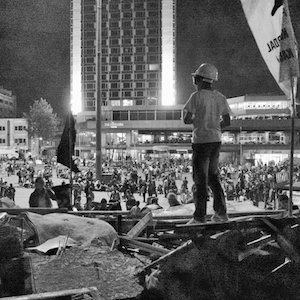 Tear gas is a very good place to start trying to understand what is happening in Turkey. The main purpose of tear gas is to terrorise and thus break up large crowds of people. In Istanbul over the last weeks huge quantities have been used over and over to prevent large anti-government demonstrations developing. This wasn't about 'riot control' - generally there was no riot to control. In this piece I'm going to put the Gezi park revolt in the context of the cycle of struggles that began in 2010 and of the specific economic, politcal and historical situation of the Turkish republic to try and draw out the lessons for all of us fighting global capitalism.
Tear gas is a very good place to start trying to understand what is happening in Turkey. The main purpose of tear gas is to terrorise and thus break up large crowds of people. In Istanbul over the last weeks huge quantities have been used over and over to prevent large anti-government demonstrations developing. This wasn't about 'riot control' - generally there was no riot to control. In this piece I'm going to put the Gezi park revolt in the context of the cycle of struggles that began in 2010 and of the specific economic, politcal and historical situation of the Turkish republic to try and draw out the lessons for all of us fighting global capitalism.
The first time I was gassed I was taking a photo of four American tourists in Taksim square, they in turn were snapping a self portrait using an iPad 2. A tranquil scene with the other people in view chatting and holding hands. From where I was standing near the Ataturk monument you couldn't see a single cop. Yet without warning tear gas canisters suddenly came raining down on every part of the huge square, a use designed to create a panicked stampede. On Mayday 1977 42 people had died in Taksim square and hundreds were injured after snipers created a panicked stampede by firing into that year’s Mayday demonstration. Perhaps because of that history - which would be as familiar as Bloody Sunday in Ireland or Kent State in the USA - the reaction of the crowd to that massive tear gas attack was very disciplined, people retreated slowly.
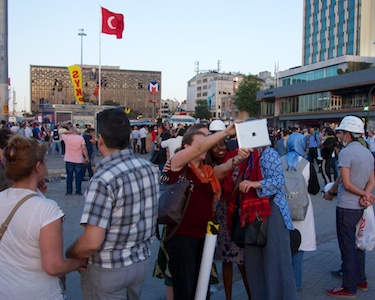 The clouds of gas choking entire streets along with yet more dangerous blasts of water canon is what you have seen online and on the TV. But those clouds also tell you something essential about the nature of Turkish 'democracy'. And that is even if the prime minister Erdogan is properly elected there is little room for dissent and protest. There are always differences between the expectation of a 'right to 'protest' and reality. Occupy Wall Street also saw the use of tear gases on protesters. But in Turkey that disconnect is particularly severe due to the way gas is used. An article in the English language daily Hurriyet revealed that 130,000 canisters of tear gas had been used by police in the first 20 days of the protests.
The clouds of gas choking entire streets along with yet more dangerous blasts of water canon is what you have seen online and on the TV. But those clouds also tell you something essential about the nature of Turkish 'democracy'. And that is even if the prime minister Erdogan is properly elected there is little room for dissent and protest. There are always differences between the expectation of a 'right to 'protest' and reality. Occupy Wall Street also saw the use of tear gases on protesters. But in Turkey that disconnect is particularly severe due to the way gas is used. An article in the English language daily Hurriyet revealed that 130,000 canisters of tear gas had been used by police in the first 20 days of the protests.
Many of those tear gas canisters were fired horizontally at close range at protesters resulting in a huge number of head injuries, a dozen people losing eyes and along with other causes, including one death from live ammunition, at least four deaths. At all the entrances to Taksim square street traders had replaced their normal goods with piles of construction hats, goggles and dust masks. I generally reached Taksim by walking the length of Istiklal, the long shopping street familiar from photos because of the strings of decorative lights overhead. As you neared Taksim you would see more and more people with bandaged forearms, heads and eyes. Even the BBC journalist Paul Mason got hit in the head (he was wearing a helmet) during the weekend he spent reporting from Istanbul.
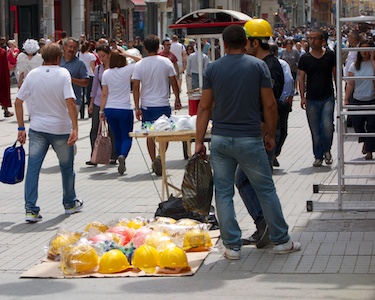 Sunday 16th June,the day after the huge police assault that have cleared Gezi Park served as an illustration of Erdogan's democracy. On the one hand thousands of free buses and ferries had been used to bring people to an enormous pro-government rally on the outskirts of Istanbul. As many as 300,000 people were gathered there to listen to a two hour tirade from the Erdogan during which he laid down his paranoid fantasies about Gezi park being part of the international conspiracy against Turkey.
Sunday 16th June,the day after the huge police assault that have cleared Gezi Park served as an illustration of Erdogan's democracy. On the one hand thousands of free buses and ferries had been used to bring people to an enormous pro-government rally on the outskirts of Istanbul. As many as 300,000 people were gathered there to listen to a two hour tirade from the Erdogan during which he laid down his paranoid fantasies about Gezi park being part of the international conspiracy against Turkey.
Meanwhile in the rest of Istanbul squads of police equipped with tear gas and rubber bullets spent the entire day swooping on any attempt by protesters to meet up, even in small numbers. They were backed up by water cannon and armoured personnel carriers that appeared whenever a larger crowd appeared. All the while, secret police snatch squads in plain clothes waited up the side streets to scoop up unwary protesters who had become isolated. Later in the day Amnesty International had released a statement demanding to know what had become of those detained- an estimated 400+ people. After Erdogan's rally ended there were multiple reports of youth members of his AKP party carrying sticks and knives accompanying police patrols.
Erdogan is no Hitler
Erdogan is however popular with a large segment of the population and there is some justification for this. As a Turkish friend explained to me as we walked between the tents in Gezi, Erdogan brought in welfare programs that made a real difference to the lives of the poorest sections of Turkish society. Unlike the rest of Europe, the Turkish economy is growing fast, fuelled in part by a development boom that the intended Gezi park development is just one aspect of. As with neo-liberalism elsewhere most of the benefits to this growth flow to a very narrow sector of society, the ruling class / 1%. But the sudden sharp decline in living standards that the working class / 99% faced across Europe and North America with the onset of the crisis and which generated Occupy and M15 do not yet have a parallel in Turkey.
There may be little room for any expression of dissent but broadly there was even less before he came to power. The important exception being that Ergogan is imposing new, religiously-inspired morality laws, such as limiting the hours during which alcohol can be sold. In a society polarised particularly along religious versus secular lines, Erdogan still speaks for a large segment of the population. He has made use of this with populist (but false) claims that the protesters had a 3 day drinking binge in a mosque - the Imam of that mosque got fired for saying this wasn’t true. A poll taken during the protests showed he still had the approval of 53%, one of the highest approval ratings of any European leader even down on the previous year. The same poll showed Turkish society was evenly split as being for and against the protests.
The Human Rights Foundation of Turkey estimated that around 640,000 people had participated in the anti-government demonstrations by the 5th June. When you factor in the other rallies Erdogan is staging its probable that both sides are mobilising similar numbers, although of course one has free transport and the other gets free tear gas. But again we are talking of a society fractured down the middle, not polarised on class lines but roughly along urban v rural, religious v secular and old v young lines.
 This means Gezi Park has a more of a resemblance to Occupy and the 15m movement than to Tahir and the fight for Egyptian democracy. The struggle in Turkey is not a struggle for parliamentary democracy - this already exists and, while there are flaws, they are not of a different magnitude than the similar problems found elsewhere in Europe or North America. The difference is also apparent when the defence of the square is analyzed: in Tahir, Egyptians took up cobblestones and catapults in huge numbers to prevent their eviction by hordes of police using tactics similar to Istanbul. Hundreds died in the conflicts that followed but they held the square.
This means Gezi Park has a more of a resemblance to Occupy and the 15m movement than to Tahir and the fight for Egyptian democracy. The struggle in Turkey is not a struggle for parliamentary democracy - this already exists and, while there are flaws, they are not of a different magnitude than the similar problems found elsewhere in Europe or North America. The difference is also apparent when the defence of the square is analyzed: in Tahir, Egyptians took up cobblestones and catapults in huge numbers to prevent their eviction by hordes of police using tactics similar to Istanbul. Hundreds died in the conflicts that followed but they held the square.
In Istanbul defence was often passive, barricades were built but generally not defended, stone throwers were few and far between. Crowds would form out of side streets, perhaps build a barricade and then be tear gassed and disperse only to reform when the police had moved to attack a crowd elsewhere - a process demonstrated in this timelapse video of one intersection in Istanbul. Active defence of the barricades was mostly tokenistic unlike the Tahir spring when the air was often dark with cobbles heading for police lines, DAF circulated a beautiful piece on the spirit of the barricade defences.. There were a couple of instances of Molotovs being thrown but in the best documented case this appeared to be undercover police sent in to create excuses for more severe police intervention around Gezi park later that day.
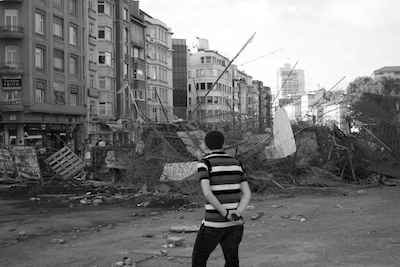 The limit to confrontation - at least from the Gezi park occupiers side - went so far as to create chains of protesters to prevent clashes with the police, presented as a defence against provocateurs. Some North American insurrectionists denounced this online but generally they failed to understand the very different context of the movement in Istanbul in comparison with, say, Oakland. The issue of the tactical use of violence at protests is a complex one that I don't intend to fully explore here but I'm certainly not a pacifist and think in many circumstances pacifism can be counter productive.
The limit to confrontation - at least from the Gezi park occupiers side - went so far as to create chains of protesters to prevent clashes with the police, presented as a defence against provocateurs. Some North American insurrectionists denounced this online but generally they failed to understand the very different context of the movement in Istanbul in comparison with, say, Oakland. The issue of the tactical use of violence at protests is a complex one that I don't intend to fully explore here but I'm certainly not a pacifist and think in many circumstances pacifism can be counter productive.
While stone throwing or window smashing at Occupy Oakland was presented as a PR problem by those opposed to it, in Istanbul it was feared that these actions would present an excuse for a much more forceful police presence and, perhaps, even military intervention. The European Minister warned, "From now on the state will unfortunately have to consider everyone who remains there [Gezi Park] a supporter or member of a terror organization." Erdogan was also describing the occupiers as terrorists in the media. In a context in which many were afraid that, if an excuse were provided, they would face live ammunition, they opted to limit themselves to tactics that might confine repression to tear gas and high pressure water jets. The historical context being the suppression of the left in Turkey in the 70’s and 80’s that saw similar brutality, torture and disappearances to the suppression of the South America left in the same period. Those keen to discuss the adoption of such tactical positions on part of the Gezi Park occupiers should make some effort to at least address the reality faced there, which may be very different from their own.
Tweeting the cycle of squares
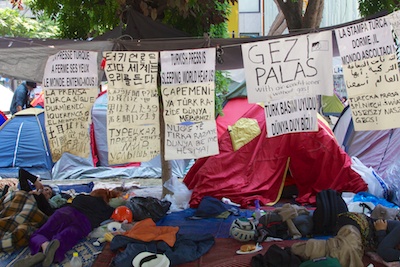 Gezi Park is the start of the 4th round of struggle around squares, if we understand this starting in 2011 in Cairo, continuing to the global Occupy movement, and then to M15 in the Spanish state. All of these have unique characteristics of their own but also significant aspects they have in common include inspiration, methodology and appearance, not least the # appearing on just about every piece of literature, banner and poster. All are part of a common learning process as we watch and learn from each other and indeed visit and participate. One of the first serious injuries in Istanbul was to a visitor from Cairo. In my own time spent in Gezi, I met people from all over Europe, North America and further afield--a tiny minority of the total crowd, but people who felt that we were all on a common journey. At least five of us from Ireland were there at one point or another, and probably many more, and I met people I knew from Zapatista solidarity work almost two decades ago.
Gezi Park is the start of the 4th round of struggle around squares, if we understand this starting in 2011 in Cairo, continuing to the global Occupy movement, and then to M15 in the Spanish state. All of these have unique characteristics of their own but also significant aspects they have in common include inspiration, methodology and appearance, not least the # appearing on just about every piece of literature, banner and poster. All are part of a common learning process as we watch and learn from each other and indeed visit and participate. One of the first serious injuries in Istanbul was to a visitor from Cairo. In my own time spent in Gezi, I met people from all over Europe, North America and further afield--a tiny minority of the total crowd, but people who felt that we were all on a common journey. At least five of us from Ireland were there at one point or another, and probably many more, and I met people I knew from Zapatista solidarity work almost two decades ago.
I spent some time in Gezi talking to one of the DAF (Revolutionary Anarchist Action) militants about where she saw this struggle fitting into both Turkish and global politics. As is now usual we exchanged web addresses and emails and on checking the website of the anarchist group most visible in the square, DAF I found they had not only written a detailed analysis of Occupy & Tahir but they had also translated it into English . At least for a few days in June Gezi park was the focus point of a movement that is global and everyone I talked to there was well aware of that.
Part of the background noise of this period has the organisations of the old left rubbing against these new movements, often in counterproductive ways. This includes the demand that the new movement use old organisational forms and adopt old terminology for expressing itself despite the fact that it is the new forms and expressions that created these movements. Central to this process is the transformation of organisational methods made possible by the internet - a transformation that in many ways is sweeping away the remaining usefulness of old left forms of organisation. To stroll into Gezi was to stroll into a world where twitter hashtags adorned every surface, banner and poster - even the tents were covered in hashtags. When you were elsewhere in Istanbul you could tell when fresh rounds of police repression were underway because you suddenly started to see a lot of people walking around staring at their smartphones.
I'd no data roaming in Istanbul so whenever I headed over to Gezi a friend in Ireland would keep an eye on Twitter so she could text me warnings if it looked like things were getting out of control. And I soon realised that I was probably more useful adding the context I'd gained through being there to tweets and retweets from my hotel than running around the streets. The Istanbul revolt should end the empty debate over whether social networking is important in real world organising - that distinction itself has no real meaning anymore. When Erdogan declared "Social media is the worst menace to society" and that "There is now a menace which is called Twitter" he was simply expressing the outrage of a ruler who discovers his comprehensive control over media and information was no longer as powerful.
Class
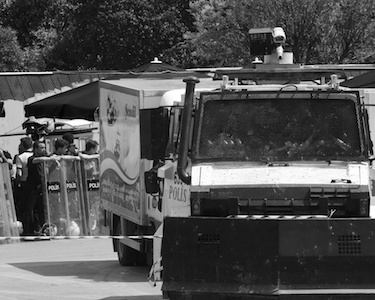
Gezi Park had at least one major difference to Occupy in that it lacked almost completely the crude class analysis of the 99% versus 1%. (I call this analysis 'crude' because that is what it is, not as a put down.) While I saw countless banners and posters with #OccupyGezi on them I don't believe I saw or heard a single use of the 99% meme. Given the popularity of Erdogan with Turkey's rural poor, the lack of any class perspective coming from Gezi meant that one of the few tools that might have undermined the rural versus urban polarisation was not present. The demands of the Taksim Platform do not go beyond the issues of environmentalism, corruption and police repression. Even in terms of the broader movement, class or economic issues didn't really feature--the expanded scope instead was summarised on Wikipedia as being limited to "freedom of the press, freedom of expression, freedom of assembly, and the government's encroachment on Turkey's secularism." Another measure of the lack of a class struggle aspect to Gezi was that a remarkable "48 percent of the 137 CEOs in Turkey said they had visited Gezi Park during the anti-government protests and around 90 percent of them found the protesters’ claims justified."
The lack of a class struggle perspective was curious because the organised left and union movements were visibly much more central to Gezi than they were to almost any Occupy camp. The more radical unions called ‘general strikes’ against repression, though union membership is very low in Turkey and radical unions account for perhaps 2% of the workforce at best. Libcom’s “Sleepless in Istanbul” blog has a good analysis of the realities of Turkish union militancy.
As soon as you arrived to Taksim square you saw the banners of Turkish and Kurdish leftist groups. A Turkish friend did however offer the opinion that the size of the banners was often inversely proportional to the groups membership and influence. Polls suggest that the presence of stalls and banners may not have indicated that much of an identification with those organisations from the mass of participants.
A poll by Bilgi university found that the vast majority of protesters had no connection to any political party. The primary motivation for joining the protests was anti-authoritarianism. More than 90% cited various aspects of authoritarian politics as what they opposed. Nearly 82% defined themselves as libertarian, in the European rather than North American sense of the word, as 75% also said they were not conservative. 92% had not voted for the ruling AKP.
Inside Gezi Park
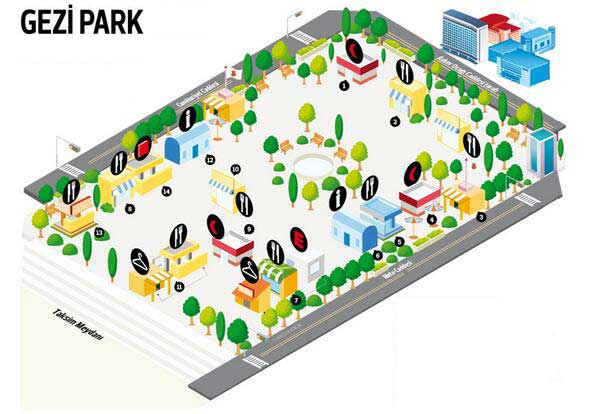
The issue that sparked the movement was the planned cutting down of the trees in the park as part of a construction project. The project was already well underway which meant large areas of the square were already partly demolished, in particular the western side where the park was raised four or so meters above the square and the buildings sunk into that part at ground level on the square had been partly demolished. Between scaffolding, construction hoardings and rubble, there was a lot of material in Taksim for the construction of barricades.
The park is in fact raised from street level on all four side with the difference being considerable on two of them. Even before the construction of barricades it was already quite a defensible space. By the time I visited, all of the unpaved inside the park were packed with tents--hundreds of them--turning the park into a warren of narrow streets decked out with banners and posters fixed to trees. Various organisations, including the anarchist DAF , had set up stalls in the more open areas. At the centre of the park where there is a fountain, a stage was set from which music was played and announcements made.
The bottom southeastern corner of the park had some larger tented areas which provided services including a medical clinic and a kitchen where free meals were distributed. Scattered throughout were tables on which bottles of cloudy Malox solution were available in case of tear gas attack. A number of commercial street stalls sprang up, some selling food, many others supplying their new customers with construction helmets, dust masks and swimming goggles.
The atmosphere in the early evening in particular was festive as hundreds of people came into the park and thronged its pathways. Because my first experience had been the near mass panic of the huge tear gas attack in the square, I found these times a little nerve-wracking as I imagined the panic that would be caused by tear gas suddenly descending into all the claustrophobic and crowded corners amongst tents packed in between the trees.
As far as I can tell the Gezi Park events did not receive anything like the international coverage of the police repression in Taskim Square. This is not surprising, as news footage of people sitting around in tents doesn't have the same dramatic impact as clouds of teargas or someone being knocked off their feet by a water cannon blast. The park is reasonably large and takes up about 1/3 to 1/4 of Taksim square, if it was visible at all in the TV footage it tended to be just the burned out cars forming a barricade at the main entrance onto the square.
An intersectional practise?
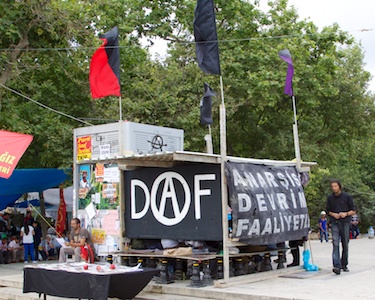 Through the physical act of sharing public space and the need to collectively resist a common state repression taking the very concrete form of tear gas and water cannon, Gezi Park was in some respects a practise of intersectionality. The span of organisations that had set up tents and stalls seemed enormous--the left, various nationalists, feminists, LGBT groups and environmentalists all had banners and posters up. A strikingly large number of individual tents had Anarchist circled A's on them and there were a lot of anarchist banners as well as a large stall of the Revolutionary Anarchists at the entrance plaza just behind the barricades on Taksim Square. There was conflict internally, as I saw a couple of angry exchanges both between the Kurdish left and right-wing Kemalist Turkish nationalists. Given the extreme divergence between their views and the bloody history of Turkish nationalism, these were mild.
Through the physical act of sharing public space and the need to collectively resist a common state repression taking the very concrete form of tear gas and water cannon, Gezi Park was in some respects a practise of intersectionality. The span of organisations that had set up tents and stalls seemed enormous--the left, various nationalists, feminists, LGBT groups and environmentalists all had banners and posters up. A strikingly large number of individual tents had Anarchist circled A's on them and there were a lot of anarchist banners as well as a large stall of the Revolutionary Anarchists at the entrance plaza just behind the barricades on Taksim Square. There was conflict internally, as I saw a couple of angry exchanges both between the Kurdish left and right-wing Kemalist Turkish nationalists. Given the extreme divergence between their views and the bloody history of Turkish nationalism, these were mild.
I can't describe the working methods of Taksim Solidarity, the umbrella organisation beyond saying that, when the response to the meeting with Erdogan was being debated, I sat in on an assembly of more than forty people discussing what to do, which took place the evening before the final (to date) violent eviction. The dynamics and methodology of the assembly were similar to those of many Occupy assemblies elsewhere, with no visible hierarchy amongst speakers. Everyone was able to participate in a fairly loose, informal setting involving a lot of discussion time.
What was being debated was whether or not to leave. A number of positions were expressed:
- that the park was in danger of being isolated from the population so what could be achieved by staying was limited
- that an example of direct democracy should be created, whatever the cost, to inspire the world that was watching
- radical unions proposed removing all of the tents, except for the token presence of a large tent
- that enough time should be made for a proper discussion, with a decision period over the following three days rather than immediately
I left before that sub assembly was moving towards a decision. The following day, confused reports emerged. It seemed like the proposal to have a token presence of tents was adopted but no one was to be compelled to pack up, which meant the big political tents mostly left but many individual ones stayed. In any case, that evening, the police launched a massive operation against the park using tear gas, water cannons, and then APC's to sweep in and bulldoze whatever remained. People who fled the park, as well as those who gathered to protest, were subjected to further tear gas in the surrounding streets. Others who took shelter in the Davan hotel were trapped for hours as police tried to gain entry. Tear gas was thrown into the lobby at one stage, despite the presence of a number of people trapped in the building. Attempts to reach the park continued long into the night with police repeatedly tear gassing the surrounding streets as, rather bizarrely, city workers planted flowers in the now empty park. A rather peculiar PR exercise that someone perhaps foolishly thought would distract from the gas and water cannon footage.
The final? repression of Gezi
 The media tendency has been to describe the 36 hours of tear gassing that spread across Istanbul following the parks eviction as rioting. I'm not sure of the accuracy of this term as from what I could tell there was very little offensive action against the police (i.e. stone throwing) and very little property destruction. Instead, the police attacked groups of protesters as they attempted to form up anywhere in the city or as soon as they started to moved towards Taksim. Where they did manage to meet in any number, protesters would construct elaborate barricades.There is a lot of construction underway in central Istanbul and protesters were quite skilled at working together in dozens to move material from construction sites to road junctions via long human chains, passing whatever was available from hand to hand. Very substantial barricades that offered some protection from police vehicles attempting to run people down sprang up in this manner.
The media tendency has been to describe the 36 hours of tear gassing that spread across Istanbul following the parks eviction as rioting. I'm not sure of the accuracy of this term as from what I could tell there was very little offensive action against the police (i.e. stone throwing) and very little property destruction. Instead, the police attacked groups of protesters as they attempted to form up anywhere in the city or as soon as they started to moved towards Taksim. Where they did manage to meet in any number, protesters would construct elaborate barricades.There is a lot of construction underway in central Istanbul and protesters were quite skilled at working together in dozens to move material from construction sites to road junctions via long human chains, passing whatever was available from hand to hand. Very substantial barricades that offered some protection from police vehicles attempting to run people down sprang up in this manner.
Particularly when the meeting with Erdogan was underway, huge amounts of police were deployed in the area around Taksim, presumably out of fear of the consequences for commanders if the square was reoccupied mid-rant. This pushed the barricades a long way from the square, even to the Galatia bridge, where trams had stopped their crossings, perhaps 1.5km from Taksim. Regular rounds of tear gas explosions could even be heard in the tourist quarter of the Golden Horn. Meanwhile, from many of the distant suburbs, similar stories emerged of large numbers taking to the streets, blocking roads and being tear gassed and shot with water cannons in punishment.
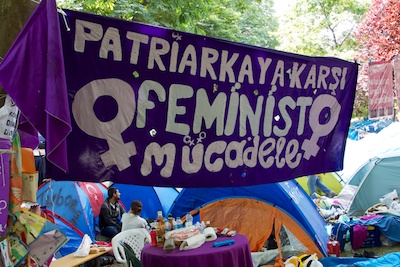 Earlier that day, in Ankara, police attacked the funeral of a protester killed earlier that week with tear gas and water cannon. A striking photo circulated showing the front of the funeral cortege in thick tear gas as a water cannon jet cut through the gas close to the pall bearers carrying the coffin. There were over 400 arrests. Many of those arrested disappeared for 24 hours or more before they appeared in the formal detention system.
Earlier that day, in Ankara, police attacked the funeral of a protester killed earlier that week with tear gas and water cannon. A striking photo circulated showing the front of the funeral cortege in thick tear gas as a water cannon jet cut through the gas close to the pall bearers carrying the coffin. There were over 400 arrests. Many of those arrested disappeared for 24 hours or more before they appeared in the formal detention system.
This massive repression prevented re-occupation of the park in the short term but failed to shut down the movement. Five of the smaller unions declared a two day 'general strike'. Publicly visible protest reappeared through the ultra-pacifist 'standing man' actions where people literally just stood in Taksim square and elsewhere. This tactic spread from Taksim and took in other issues including honouring Hrant Dink the Armenian journalist assassinated in 2007 and the 5 workers who died from methane inhalation at a recycling plant last week due to lack of health and safety regulation & equipment.
Police initially tried to end the ‘standing man’ protests through arrests but more people just started to stand and the nature of the tactic means that its almost impossible to present arrests as anything other than repression. Bizarrely the deputy prime minister tried to claim that standing still for longer than 8 minutes was bad for your health - as if that somehow justified the arrests.
The assembly process spreads
Most importantly, assemblies started to happen in public spaces all over the city, the largest involving thousands of people. At the time of this writing, these neighbourhood forums reportedly took place in 35 parks across Istanbul. One of them was described as follows:
"From 9pm, thousands of mostly young people assembled in and around the amphitheater in Abbasaga Park under the motto ‘every park is Gezi’ .. to assess what has happened since the Gezi Park occupation began and where the movement is going. Hundreds lined up behind the stage to talk for two or three minutes each, while the assembled crowd signaled agreement and disagreement by waving their hands or crossing their arms."
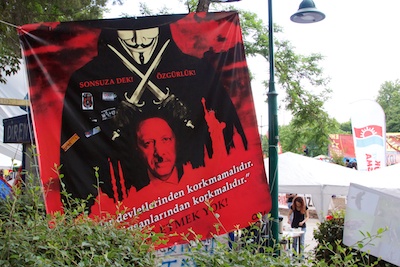
Like the Occupy movement, the radical nature of the movement in Turkey lies not in its formal demands but in its processes. In fact, as we have seen, although the violent repression of the Turkish state makes the movement appear more radical, its actual demands (as represented by the Taksim Platform) are very moderate indeed. As with the M15 movements, the movement in Turkey refuses to accept Erdogan’s rationale that 'we are the democratically elected government' as a reason to end the protests. Sometimes, this is dressed up in language that insists the government is 'really' a dictatorship: in Gezi park there were a couple of posters representing Erdogan as Hitler. This liberal window dressing - of Erdogan as dictator - masks a deeper reality that what is being rejected is the fundamental basis of parliamentary democracy. Another illustration of this is like the movements elsewhere there is very little identification with political parties, the Biligi survey (above) reported that "only 15.3 percent said they felt close to a political party" - this is very close to the similar figure reported from surveys of the mass protests in Brazil.
For anarchists, the massive rejection of parliamentary democracy and its replacement with forms of direct democracy cannot be anything other than exciting. Most of the left is horrified, insisting that the protesters need to move into 'real politics'. Because many of them are young this is often presented in a patronising 'they will grow up to understand this' manner that completely fails to understand that this rejection is based as much on the failed historical experience of left parties as anything else. The concept of forming parties of the left is hardly new in Turkey. It had and still has a very substantial revolutionary left. In short it is not the protesters who need to learn lessons about parties, it is these commentators trapped in old certainties. A new form of fighting for social transformation is clearly developing but we need to get beyond seeing it, simplistically, as a repeat of 1848 or the Paris Commune, leading to an inevitable channeling into Social Democracy.
On the other hand, these movements have not yet evolved a path to social transformation. The assemblies may represent the new world growing within the old but as yet no collective program exists to overcome and replace the repressive state. Perhaps most importantly, although some unions have had serious mobilisations to support Gezi and similar movements elsewhere, the assembly form has only come into existence in public spaces and neighbourhoods. We can be fairly certain that CEO approval rate of the movement will plummet if (and, hopefully, when) workers start to assemble in their workplaces to discuss the future of the companies they work for. It is probably not till this happens that concrete economic measures can be formulated, not so much as abstract slogans but as concrete practises that can be implemented. We have seen such forms emerge in the past: they emerged rapidly in terms of the Occupied factories of the Argentinian crisis of 2001. But there they were very much a defensive measure to prevent factory closure and the loss of livelihoods. In Turkey, in particular with its growing economy, a movement of assemblies in the workplace is unlikely to develop as a defensive protection of livelihoods.
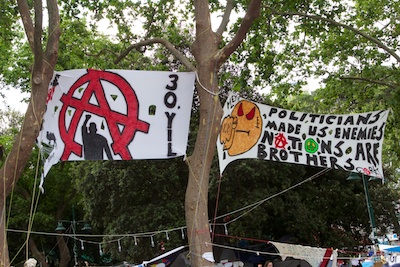 Anarchists need to make greater progress in adapting themselves to the realities of these new movements. This means being flexible enough to move beyonds criticisms that they may not be taking the form we might wish for. Anarchists have a long and well established theories and practice of direct democracy. We need to think of ways to present these that are useful, reducing the need to reinvent the wheel. Collectively, we have a deep understanding of how wealth and power connect. Can we bring that understanding into movements, popularising it in ways that go beyond the limitations of the 99% meme? In recent decades, sections of the anarchist movement have developed with other movements--in particular feminist, anti-racist and queers--a much deeper understanding of the way oppressions intersect with each other. These offer real potential to work with other ‘movements of the square’ develop into the start of real efforts to achieve collective human liberation.
Anarchists need to make greater progress in adapting themselves to the realities of these new movements. This means being flexible enough to move beyonds criticisms that they may not be taking the form we might wish for. Anarchists have a long and well established theories and practice of direct democracy. We need to think of ways to present these that are useful, reducing the need to reinvent the wheel. Collectively, we have a deep understanding of how wealth and power connect. Can we bring that understanding into movements, popularising it in ways that go beyond the limitations of the 99% meme? In recent decades, sections of the anarchist movement have developed with other movements--in particular feminist, anti-racist and queers--a much deeper understanding of the way oppressions intersect with each other. These offer real potential to work with other ‘movements of the square’ develop into the start of real efforts to achieve collective human liberation.
As I conclude this piece, the assembly movement appears to be spreading across Turkey. Enormous demonstrations have erupted in Brazil. We are all watching new moments in a cycle of struggles that started in Tunisia in 2010, now running into its third year. So far, all have faded short of victory, although gains have been made. Still, clearly, we are engaged in a global learning process that is generating a new revolutionary politic. The promise of achieving what our methods failed to realize in the 20th century--freedom for all--remains. For anarchists, the question is: how can we best build and influence this movement in the context of remembering the hard lessons of previous failures and without becoming stuck in the historical memory of brief moments of past glory? We must be midwives of this new movement rather than archivists of the old.
WORDS & IMAGES: Andrew Food (follow me on Twitter)
(thanks to Christine & Fin for proofreading)
Dublin meeting 27th June- Andrew Flood, member of Workers Solidarity Movement, will give an eyewitness account of the state brutality against people in Istanbul, where he spent a week recently. Sevinc Karaca, an anarchist from Turkey, will give details of the background of the struggle. The talks will be accompanied by photos & video from Gezi park.
Event notice at http://www.facebook.com/events/142397865956314/ please RSVP there and invite your friends


Comments
NEED FOR GAS MASKS
YOUR ARTICLE CORRECTLY POINTS OUT THE NEED FOR ACTIVISTS TO WEAR GAS MASKS TO DEFEND AGAINST TEAR GAS AS AN ITHACA GAS MASK OWNER AND GAS MASK RIGHTS ADVOCATE, I SUPPORT THOSE WEARING GAS MASKS TO FEND OF STINGING AND IRRITATING FUMES OF TEAR GAS I WOULD HAVE BEEN WEARING MY GAS MASK TO AVOID TEARY EYES, RUNNY NOSE, COUGHING AND SNEEZING EFFECTS OF TEAR GAS MY MOTTO IS "WEAR A GAS MASK TO AVOID THE AGONY AND MISERY OF TEAR GAS" A GAS MASK IS THE ONLY WAY TO BEAT THE SUFFERING INFLICTED BY TEAR GAS--TEARY EYES, RUNNY NOSE. COUGHING AND SNEEZING ITHACA, NY GAS MASK OWNERS SUPPORT YOUR RIGHT TO WEAR A GAS MASK TO DEFEAT THE IRRITATING AND STINGING EFFECTS OF TEAR GAS
one addition
Firstly, this was the best article i've read so far about Gezi Park, but one of the informations has changed recently and i would like to point that:
*Today, the Ministry of Interior announced that the number of people who protested government all over the country was 2.5 million (So it wasn't 600.000) and in addition to that, 4900 of these people was detained, and approximately 4000 people got injured during the event.
And since it's the government statement, I believe that these number could be much higher then they claim.